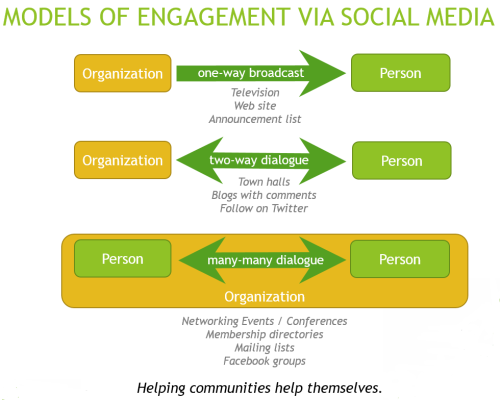I gave a couple of talks in April discussing how to foster innovative communities of practice (one at the Cultural Congress hosted by the Washington State Arts Alliance, and one for the e-gov subcommittee of the CTTAB).
Presentation highlights:
Due to the ubiquity of social media, there’s been a paradigm shift in how group’s of people work together, which also affects how organizations (government, NGO, or companies) engage with the public.
There are several models for citizen engagement via social media, the one we at Third Place Technologies seek to explore is how to best provide environments that empower members of communities to connect with each other — helping communities help themselves.
We are working on a couple of prototyping projects that are focused on helping communities connect, including Brink NW, a crowd-sourced community network of people, organizations, events projects, optimized for interdisciplinary, cross-organizational collaboration.
As a part of this effort, we are focusing on three communities to start — the art & tech community in the Northwest, the civic tech community in the Northwest, and the International District as a neighborhood community. A key aspect of this project is to engage in data-driven, socially intelligent design — that is, to develop a community networking tool that best maps onto the existing structure of real-world communities of practice. Consequently we’ve been actively engaged in acquiring a lot of information about these communities, including what we are calling a “community mapping survey”.
We recently distributed one of these community mapping survey’s to the civic tech community at the Open Data Day in February, and presented some key findings from this survey (see slides 21-32).
In asking participants to articulate the community’s goals, they expressed the strongest interest in having civic tech exhibitions/show and tells, and then educational workshops.
It was clear from the survey, that as a new, emerging community of practice, people had some difficulty connecting with others — knowing who’s who, and what projects were active, and whey they could plug in, so to speak, with their skill sets.


